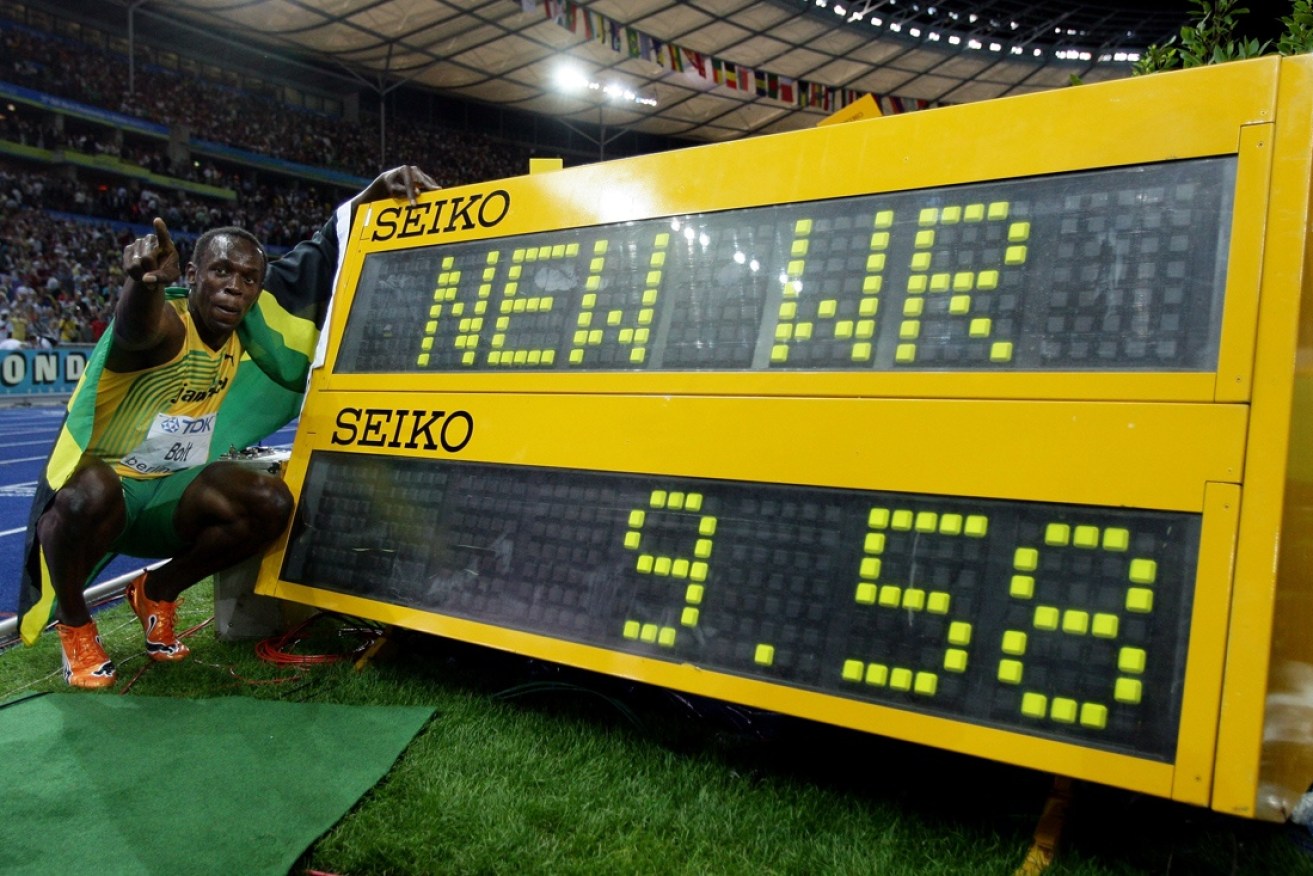This is the reason Usain Bolt is so darn fast

Bolt holds the 100m world record. Photo: Getty
Usain Bolt appeared on a video screen in a white singlet and black tights, sprinting in slow motion through the final half of a 100-metre race.
Each stride covered nine feet, his upper body moving up and down almost imperceptibly, his feet striking the track and rising so rapidly that his heels did not touch the ground.
Bolt is the fastest sprinter in history, the world-record holder at 100 and 200 metres and the only person to win both events at three Olympics.
Yet as he approaches his 31st birthday and retirement this summer, scientists are still trying to fully understand how Bolt achieved his unprecedented speed.
Last month, researchers at Southern Methodist University (SMU), among the leading experts on the biomechanics of sprinting, said they found something unexpected during video examination of Bolt’s stride: His right leg appears to strike the track with about 13 percent more peak force than his left leg.
And with each stride, his left leg remains on the ground about 14 percent longer than his right leg.
This runs counter to conventional wisdom, based on limited science, that an uneven stride tends to slow a runner down.
So the research team at S.M.U.’s Locomotor Performance Laboratory is considering a number of questions as Bolt prepares for what he said would be his final performances at a major international competition — the 100 metres and 4×100-metre relay next month at the world track and field championships in London.
Among those questions: Does evenness of stride matter for speed? Did Bolt optimise this irregularity to become the fastest human?
Or, with a more balanced stride during his prime, could he have run even faster than 9.58 seconds at 100 meters and 19.19 seconds at 200 meters?
“That’s the million-dollar question,” said Peter Weyand, director of the SMU lab.
The SMU study of Bolt, led by Andrew Udofa, a doctoral researcher, is not yet complete.
And the effect of asymmetrical strides on speed is still not well understood.
But rather than being detrimental to Bolt’s performance, the consequences of an uneven stride may actually be beneficial, Weyand said.

Bolt: so fast he has even got time to look at his rivals. Photo: Getty
It could be that Bolt has naturally settled into his stride to accommodate the effects of scoliosis.
The condition curved his spine to the right and made his right leg half an inch shorter than his left, according to his autobiography.
Initial findings from the study were presented last month at an international conference on biomechanics in Cologne, Germany. Most elite sprinters have relatively even strides, but not all.
The extent of Bolt’s variability appears to be unusual, Weyand said.
“Our working idea is that he’s probably optimised his speed, and that asymmetry reflects that,” Weyand said.
“In other words, correcting his asymmetry would not speed him up and might even slow him down. If he were to run symmetrically, it could be an unnatural gait for him.”
Antti Mero, an exercise physiologist at the University of Jyvaskyla in Finland, who has researched Bolt’s fastest races, said he was intrigued by the SMU findings.
“Generally there are small differences between the right and left leg, but I think they are normally about 1, 2, 3 percent,” Mero said in a telephone interview. “This sounds a little bigger.”
Given the scoliosis and discrepancy in the length of Bolt’s legs, Mero said, the sprinter’s stride appeared optimal for him. “If the coach would try to change the pattern, it would not be good,” Mero said.
Jamaican men and women won 11 of the 18 available medals in the 100 at the past three Olympics, though the Caribbean island has a population of only 2.8 million.
Theories about Jamaican sprinting success have ranged from their proportion of fast-twitch muscle fibres to a renowned youth development system to a public health campaign dating to the 1920s.

Bolt announced himself to the world at the 2008 Beijing Olympics. Photo: Getty
Unlike elite marathon runners, who strike the ground with a force equal to about three times their body weight and who must repeat each step about 25,000 times over 26.2 miles, sprinters are not concerned with endurance and fuel efficiency over 100 meters.
Marathon runners are the bipedal equivalent of a Prius. Sprinters are dragsters, seeking to generate maximum speed and power over a short distance.
Elite sprinters do not land passively and spring back into the air as if their legs were pogo sticks, the S.M.U. lab found in two 2014 studies.
Instead, the sprinters cock the lead knee high and drive the foot into the track with a stiffened ankle.
Essentially, it is a punch delivered with high velocity and a sudden stop.
“It’s like a ball bearing hitting the ground,” said Ryan, the physicist.
Sprinters like Bolt land just behind the ball of the foot, which strikes the ground at an angle of about six degrees. His lower leg decelerates abruptly, absorbing 16 Gs of force.
His heel drops for only two-hundredths of a second — the equivalent of an inch — before rising again.
The total time spent on the ground with each stride is about nine-hundredths of a second.
In effect, there is one biomechanical way for world-class sprinters to run extremely fast.
“They’re machine-like,” Weyand said. “It’s incredible the extent to which they do the same thing.”
– New York Times








